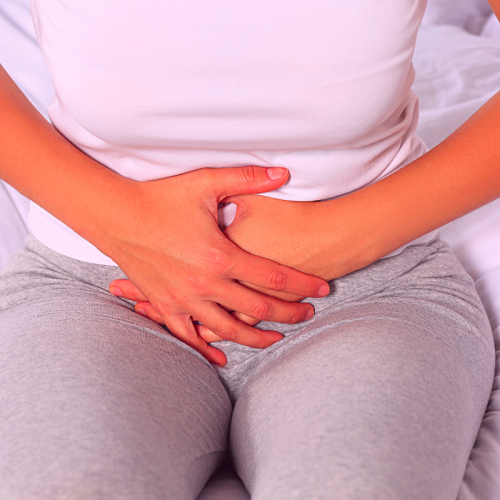Nearly half of all women will get a UTI at some point in their lifetime, and for many women it’s a recurring struggle. The most common UTI treatment is antibiotics. But that almost always requires a prescription from a medical professional. So, what to do if you wake up in the middle of the night in pain from a UTI? Are there any home remedies that can help as you wait for an appointment?
We checked out the data from the experts (including the American Urological Association) and found that yes, there are evidence-backed home remedies that can help. And, as always, some fixes that you may hear about, but don’t have evidence supporting them (yet). Read on for the full list of home remedies that can (or can’t) relieve pain caused by UTIs.
And if you need a refresher on what causes UTIs—or how to tell a UTI from other common infections, like bacterial vaginosis—check out our basics section at the end of this article.
Home Remedies for Treating UTI Pain That Actually Work…
Phenazopyridine (AZO, Pyridium, Uricalm)
Okay, so this may not be something you can make at home, but it is something you can get without a doctor’s prescription that you can keep around the house. Phenazopyridine is an over-the-counter medication that relieves pain associated with the urinary tract. It is technically a dye, and as it flows through your bladder it can help soothe the burning or need to go frequently associated with a UTI.
It’s important to know that this medication will NOT actually treat the infection – it is simply a pain reliever. Most experts recommend taking this for no more than 48 hours, as it can mask a more serious infection. And because the medication is a dye, it can change the color of your urine, often to orange or red.
Good Old Water
It seems like water is the answer to everything, but when it comes to UTIs, there is real evidence that you actually can help flush out the infection that is causing UTI pain by increasing your water intake.
One study of 140 women who had recurring UTIs (three in the prior year) and drank less that 1.5 liters of fluid daily reduced their likelihood of getting another UTI by 50% by increasing their water intake by 1.5 liters (about 50 ounces.) An even larger review that compiled data from seven studies found the number of UTIs decreased at six months. Those researchers did say more data was needed on exactly how much water should be consumed, but the most common number we saw in our research was 2 to 3 liters of water per day.
One caveat: These studies were focused on preventing future UTIs, not specifically on pain relief from current UTIs. That being said, if drinking a lot of water can flush out bacteria and prevent infections, it can theoretically help with pain by getting the bacteria out of your body.
Cranberry Juice/Extracts/Supplements
The medical community is somewhat split on this one, but there is enough evidence that urological associations in the United States and the EU have included cranberry products as potential option to prevent recurring infections. (So, like water, not to treat existing pain – but if it can prevent infections, it could theoretically help fight an existing infection.) The American Urological Association said it is possible that chemicals in cranberries and cranberry supplement known as proanthocyanidins help prevent bacteria from sticking to the lining of the urinary tract.
The group reviewed five randomized trials and found that cranberry was associated with decreased risk of getting a UTI when compared to a placebo. But four additional studies conducted since 2019 could not be added to that larger analysis, largely because they included cranberry with other treatments. One of the big challenges of studying how effective cranberry is in treating UTIs is that there isn’t a standard dosage of cranberry, or a standard way to take it, whether you drink juice or take a supplement.
A similar group in the European Union came to the same conclusion, writing that cranberry’s effectiveness in fighting UTIs “remains unclear” but that “clinicians may recommend them.” They also said there was “no clear clinical evidence regarding the appropriate dose and treatment duration.” Both groups added that there is little harm in taking cranberry, besides the potential of drinking lots of extra sugar. You can look for unsweetened cranberry juice to avoid additional sugar or calories.
Get as Comfy as You Can
This is the commonsense section! Get changed into comfy clothes, especially those that are loose fitting on your bladder. You can use a hot water bottle or heating pad to relieve pain associated with cramping, and take common pain relievers like Tylenol, Advil, or Aleve. It can also help to avoid things that can irritate the bladder, like spicy food, caffeine, and alcohol. Basically, take it easy and take care of yourself as you would with a cold. (And last but not least, drink lots of water!)
…And Remedies Where It’s Not Clear If They Work
- D-mannose dietary supplements: D-mannose is a natural sugar that is often found in fruits, and there is a theory that they can bind to bacteria and ultimately decrease the number of bacteria that exist in the bladder. However there is not significant evidence that this supplement will prevent recurrent infections or treat pain associated with a UTI.
- Vitamin C / Ascorbic Acid: There are theories that Vitamin C can help make urine more acidic, which will kill bacteria. But there wasn’t much data to support this hypothesis.
- Essential oils: There was no clinical evidence that any essential oils can help treat infections of the bladders.
Urinary Tract Infection Basics
Causes of UTIs
Urinary tract infections are caused by the presence of a bacterial infection in the bladder, kidneys, or urinary tract. Officially known as cystitis, a UTI is often caused by bacteria like e. coli, lactobacilli, enterococci, or Group B streptococci (strep). That means for home or “natural” remedies to work, you need your immune system to flush bacteria out, especially bad bacteria (versus good bacteria).
Some women are more likely to have recurrent UTIs. Scientists don’t know exactly why, but women whose mothers had recurring UTIs are more likely to have them as well. It’s possible that women UTIs more frequently than men because women have a shorter urethra, meaning there is less distance for bacteria to travel. And that puts you at higher risk for infection. (Thanks, biology!)
UTI Symptoms + Prevention
The main symptoms of a UTI are painful urination (it can be a burning sensation when you urinate), the need to urinate frequently, and pain in your lower abdomen. The main way to tell you have a UTI versus other common genital infections, like bacterial vaginosis, is if there is painful urination and/or needing to urinate urgently and frequently WITHOUT vaginal itchiness or discharge.
Pay close attention to your symptoms to identify a bladder infection versus a kidney infection. Clinicians separate cystitis into complicated versus uncomplicated UTIs. A “complicated” UTI is an infection that has gone beyond the bladder and the lower urinary tract, and, for example, has reached the kidneys. Signs of a complicated UTI include fever, blood in your urine, and lower back pain. If you have a complicated UTI you need a healthcare provider to treat you as soon as possible, as it can develop into a very serious infection.
The most common way to fight a UTI is antibiotic treatment. In addition to the methods described above, practicing good hygiene in your genital area can help prevent UTIs, especially urinating after sexual intercourse.
Sources
Cranberries for preventing urinary tract infections – PubMed (nih.gov)



